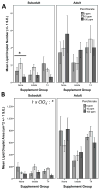Exogenous iodide ameliorates perchlorate-induced thyroid phenotypes in threespine stickleback
- PMID: 27815158
- PMCID: PMC5318228
- DOI: 10.1016/j.ygcen.2016.10.014
Exogenous iodide ameliorates perchlorate-induced thyroid phenotypes in threespine stickleback
Abstract
Perchlorate is a ubiquitous environmental contaminant that has widespread endocrine disrupting effects in vertebrates, including threespine stickleback (Gasterosteus aculeatus). The target of perchlorate is thyroid tissue where it induces changes in the organization, activation, and morphology of thyroid follicles and surrounding tissues. To test the hypothesis that some phenotypes of perchlorate toxicity are not mediated by thyroid hormone, we chronically exposed stickleback beginning at fertilization to perchlorate (10, 30, 100ppm) or control water with and without supplementation of either iodide or thyroxine (T4). Stickleback were sampled across a one-year timespan to identify potential differences in responses to treatment combinations before and after sexual maturation. We found that most thyroid histomorphological phenotypes induced by perchlorate (follicle proliferation, reduced follicle area (adults only), colloid depletion, thyrocyte hypertrophy (subadults only)) were significantly ameliorated by exogenous iodide supplementation. In contrast, treatment with exogenous T4 did not correct any of the thyroid-specific histopathologies induced by perchlorate. Whole-body thyroid hormone concentrations were not significantly affected by perchlorate exposure; however, supplementation with iodide and T4 significantly increased T4 concentrations. This study also revealed an increased erythrocyte area in the thyroid region of perchlorate-exposed adults, while lipid droplet number increased in perchlorate-exposed subadults. Increased erythrocyte area was ameliorated by both iodide and T4, while neither supplement was able to correct lipid droplet number. Our finding on lipid droplets indicates that exposure to perchlorate in early development may have obesogenic effects.
Keywords: Endocrine disruption; Histopathology; NIS; Obesogen; Sodium-iodide symporter; Thyroxine.
Copyright © 2016 Elsevier Inc. All rights reserved.
Figures







References
-
- Arntzenius AB, Smit LJ, Schipper J, Heide DVD, Meinders AE. Inverse relation between iodine intake and thyroid blood flow: Color doppler flow imaging in euthyroid humans. The Journal of Clinical Endocrinology & Metabolism. 1991;73:1051–1055. - PubMed
-
- Blanton ML, Specker JL. The hypothalamic-pituitary-thyroid (HPT) axis in fish and its role in fish development and reproduction. Critical Reviews in Toxicology. 2007;37:97–115. - PubMed
-
- Bradford CM, Park JW, Rinchard J, Anderson TA, Liu F, Theodorakis CW. Uptake and elimination of perchlorate in eastern mosquitofish. Chemosphere. 2006;63:1591–1597. - PubMed
-
- Bradford CM, Rinchard J, Carr JA, Theodorakis C. Perchlorate affects thyroid function in eastern mosquitofish (Gambusia holbrooki) at environmentally relevant concentrations. Environmental Science & Technology. 2005;39:5190–5195. - PubMed
-
- Carr JA, Patiño R. The hypothalamus–pituitary–thyroid axis in teleosts and amphibians: Endocrine disruption and its consequences to natural populations. General and Comparative Endocrinology. 2011;170:299–312. - PubMed
MeSH terms
Substances
Grants and funding
LinkOut - more resources
Full Text Sources
Other Literature Sources

